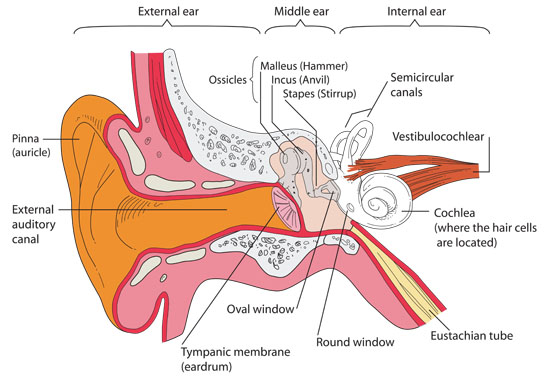Acoustics
The Science of Sound.
Anechoic Room/Chamber
Test room whose surfaces absorb all sound. Note – The word anechoic is derived from the Greek words meaning without echo.
Anvil
Also called the incus. The bone of the middle ear that is attached to the malleus (hammer) and the stapes (stirrup).

Auditory Canal
Also called the ear canal. A short tube about 1 inch (2.5 cm) long that directs sound to the eardrum.

Auditory Nerve
Also called the vestibulocochlear nerve or acoustic nerve. Acts like a telephone line to the brain. The electrical signals generated by the hair cells are sent to the brain by this nerve.

Auricle
The visible part of the outer ear – also called the pinna. If you can wiggle your ears, the auricle is what you wiggle. 

Basilar Membrane
The membrane that forms the lower boundary of the cochlear canal, and on which rests the organ of Corti, of which the hair cells of the cochlea are part.

Cerumen
Ear wax – Ear wax protects our ear canal and smells bad to bugs.
Cochlea
The snail-shaped part of the inner ear which contains the organ of Corti also known as the organ of hearing.

Control
A way for a musician to modify the musical instrument to affect the sound it produces. Musical instruments, including the voice, allow musicians to change pitch, loudness and even the tone color to some degree. For example, a trumpet can play the same note loud, brassy, and bright, or softer with a mellow tone.
Damping
Dissipation of energy with time or distance.
dB
A measure of how loud sounds are or sound intensity (abbreviation for decibel).
Dead Room
A room with a relatively large amount of sound absorption and relatively short reverberation time.
Decibel
A unit of measure commonly used to describe the sounds around us (abbreviated as dB). It’s based on a logarithmic scale which means a sound that is 3 decibels higher has twice as much energy.
Ear Canal
Also called the auditory canal. A short tube about 1 inch (2.5 cm) long that directs sound to the eardrum.

Ear Wax
Also called Cerumen. Ear wax protects our ear canal and smells bad to bugs.
Eardrum
Also called the tympanic membrane. A thin membrane that separates the outer ear from the inner ear. Sound waves make it vibrate; this vibration is transferred to the three bones of the middle ear.

Echoes
Reflections or repetitions of sound waves. Echoes can be produced and heard by clapping hands or shouting in a large empty room with hard walls or in a cave for example.
Echolocation
A method used to detect objects by producing a specific sound and listening for its echo.
Energy
The ability to do work (to move an object a distance.)
Eustachian Tube
Connects the middle ear to the throat. It’s normally closed. When you pop your ears, this tube opens up to let air in or out. 

External Auditory Canal
Also called the ear canal. A short tube about 1 inch (2.5 cm) long that directs sound to the eardrum. 

Frequency
The number of times a vibrating object oscillates (moves back and forth) in one second. Fast movements produce high frequency sound (high pitch/tone), but slow movements mean the frequency (pitch/tone) is low.
Hair Bundle
A bundle of stereocilia on top of each hair cell – sound vibrations from the stapes or stirrup bone move the fluid inside the inner ear which moves the hair bundles. The hair cells in turn signal the auditory nerve.
Hammer
Also called the malleus. The bone of the middle ear that is attached to the eardrum and the incus (anvil).

Hertz (Hz)
A measure of frequency, abbreviated as Hz. The number of oscillations (back and forth movements) per second.
Impedance
A characteristic of the substance that sound travels through. It indicates how loud a sound will be depending on frequency and the sound source. Ratio of pressure to volume flow.
Incus
Also called the anvil. The bone of the middle ear that is attached to the malleus (hammer) and the stapes (stirrup). 

Inner Ear
A complex structure of interconnected fluid-filled chambers and canals within the bone of the skull – One portion of the inner ear is not involved in hearing, but instead provides a sense of balance. The other portion of the inner ear, called the cochlea, is the organ of hearing.

Labyrinth
The interconnected fluid-filled chambers of the inner ear.
Larynx
Often called the ‘voice box,’ it is located at the top of the windpipe at the lower end of the throat. It is made up of muscles, membranes and cartilages, and contains the vocal folds (vocal cords).
Malleus
Also called the hammer. The bone of the middle ear that is attached to the eardrum and the incus (anvil). 

Microphone
A device that changes sound waves into electric signals.
Middle Ear
The air-filled space between the eardrum and the inner ear, containing the ossicles or the three middle-ear bones (the malleus, the incus and the stapes or hammer, anvil and stirrup).

Noise
Undesired sound. Or random vibrations.
Organ of Corti
Also known as the organ of hearing. The organ of Corti rests on the basilar membrane in the cochlear canal. 

Oscillation
Back and forth movement that repeats regularly between two fixed positions.
Ossicles
Three bones found in the ears of all mammals (the malleus, the incus and the stapes or hammer, anvil and stirrup). These bones are the smallest bones in a person’s body and they act like a system of levers.

Outer Ear
The external part of the ear which includes the pinna (the part you can wiggle) and the ear canal. 

Oval Window
An opening into the inner ear that is filled by the “footplate” of the stapes (stirrup bone).

Pinna
The visible part of the outer ear, also called the auricle – if you can wiggle your ears, the pinna is what you wiggle.

Pitch
How high or low a tone sounds to a person. High frequency sound has a high pitch or tone (treble notes), but low frequency has a low/deep pitch or tone (bass notes). High sounds are usually above 2000 Hertz and low below 200 Hertz.
Reflection
Bouncing back of wave energy such as light or sound. – when a wave reaches a new material part or all is reflected.
Resonance
A natural frequency of vibration determined by the size and shape of an object. For example, shorter guitar strings resonate at a higher frequency than longer guitar strings.
Reverberation Room
A room that is designed to cause even distribution of the sound field. Reverberation rooms often have very hard exposed surfaces that are not parallel.
Reverberation Time
The amount of time it takes for a sound level to decrease by 60 dB within an enclosure after the sound source has stopped.
Sensitivity
How strongly an organ or living thing reacts to something. For example, the ears are sensitive to sound while the eyes are sensitive to light.
SONAR
Sound Navigation And Ranging, is the process of listening to specific sounds to determine where objects are located. In active SONAR, a sound is transmitted and the listener uses its echo to locate objects. In passive SONAR, the listener uses the sounds emitted directly from the source of the sounds.
Sound Pollution
The concentration of sound to levels harmful to the natural environment (including humans).
Sound Source
Whatever object makes the sound. All of these are sources of sound: two hands clapping together, a person speaking or singing, a submarine echolocating, a radio playing, birds chirping, ocean waves crashing on the beach.
Sound Wave
Vibrations of air molecules that travel through air carrying energy with them. Sound waves can also travel through water and solids, but cannot travel in space where there are no molecules to vibrate. When sound travels through air, the molecules do not actually move to a new location, instead each set of molecules “bumps” the molecules next to it, progressively transferring motion to new sets of molecules farther and farther away from the sound source until the wave motion dies out. Play with the “Sound” tab on this simulation to see sound travel through air.
Spectrum Analyzer
A device used to see the different waves (frequencies) that make up a sound.
Speed of Sound
The speed at which sound travels. This is very important for scientists who study sound. In air sound travels 343 meters in 1 second (767 miles per hour), but in water sound travels 1500 meters in 1 second (3350 miles per hour). Compare these speeds to cars traveling on the highway at 65 miles per hour.
Stapes
The tiny stirrup-shaped bone of the middle ear that is connected to a window (oval window) in the cochlea. 

Stereocilia
Small finger-like or hair-like projections from the top of each hair cell in the inner ear – also see hair bundle. Sound vibrations from the stapes or stirrup bone move the fluid inside the inner ear which moves the hair bundles. The hair cells in turn signal the auditory nerve.

Stirrup
Also called the stapes. The tiny stirrup-shaped bone of the middle ear that is connected to a window in the cochlea.

Tinnitus
Ringing or other sounds in your ears or head that only you can hear.
Tuning Fork
A special instrument used for producing a specific tone (frequency) when the fork is struck
Tympanic Membrane
Also called the eardrum. A thin membrane that separates the outer ear from the inner ear. Sound waves make it vibrate; this vibration is transferred to three bones of the middle ear.

Vestibulocochlear Nerve
Also called the auditory nerve or acoustic nerve. Acts like a telephone line to the brain. The electrical signals generated by the hair cells are sent to the brain by this nerve.

Vibration
Oscillation – a shaking back and forth movement
Vocal Folds
Often called the ‘vocal cords’, are made up of two membranes on the sides of our larynx (voice box). We talk by squeezing them close together as the lungs push air between them causing them to vibrate.
Wave
A moving disturbance that transfers energy. The substance the wave moves through does not travel with the energy.
